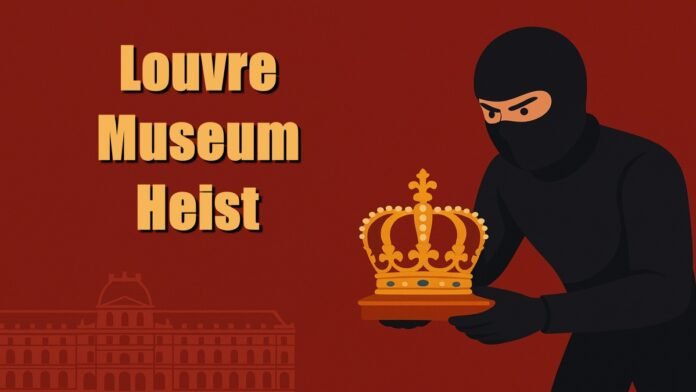
Key Highlights
- Robbers stole priceless French royal jewels from the Louvre Museum’s Apollo Gallery in just 7 minutes
- Thieves used a mechanized basket lift mounted on a truck to access first-floor windows before opening time
- Four display cases were breached containing jewels once owned by Napoleon and French empresses
- Famous diamonds including the Regent, Sancy, and Hortensia were among targeted treasures
- Interior Minister Laurent Nunes confirmed robbers escaped on motorcycles, dropping items in their haste
- Incident marks one of the rarest security breaches at the world’s most visited museum
Paris: The world-renowned Louvre Museum in Paris experienced a stunning security breach that has sent shockwaves through the international art and cultural heritage community. In a meticulously planned operation lasting merely seven minutes, sophisticated thieves managed to infiltrate one of the world’s most heavily guarded institutions and steal irreplaceable French crown jewels. The audacious heist has raised serious questions about security protocols at major cultural institutions worldwide, despite the Louvre’s protection being entrusted to France’s elite commando units.
The Precision Heist: How It Unfolded
According to detailed police investigations, the robbery was executed with military-like precision just minutes before the museum’s official opening time. The perpetrators employed a mechanized basket lift similar to those used by construction workers and window cleaners, mounted on a truck or lorry positioned outside the building. This equipment allowed them to reach the first-floor windows of the historic structure, bypassing ground-level security entirely.
The robbers strategically cut through a window to gain entry, demonstrating both technical expertise and a deep understanding of the building’s layout. Once inside, they moved with remarkable efficiency directly to the Apollo Gallery, where France’s surviving crown jewels are displayed. Their target selection was no accident; these thieves clearly possessed detailed intelligence about what treasures awaited them and precisely where to find them.
Inside the Apollo Gallery: What Was Stolen
The Apollo Gallery, located in the southern section of the Louvre Museum, houses what remains of France’s royal crown jewels, priceless artifacts that survived the tumultuous French Revolution. Most of the original crown jewels were either lost, destroyed, or sold during and after the revolution, making the surviving pieces extraordinarily rare and culturally significant.
Interior Minister Laurent Nunes confirmed that the thieves successfully breached four separate display cases during their brief incursion. The stolen items included jewels acquired after the French Revolution for Emperor Napoleon Bonaparte, his nephew Napoleon III, and their wives, Empresses Marie-Louise and Eugenie. These pieces represent not just monetary value but irreplaceable historical connections to France’s imperial past.
According to the Louvre’s official documentation, the gallery’s most valuable treasures include three legendary diamonds: the Regent, the Sancy, and the Hortensia. Each of these stones carries centuries of history and has adorned French royalty through multiple dynasties. While authorities have not yet confirmed which specific pieces were taken, the mere possibility that these historic diamonds might be among the stolen items has intensified international concern.
Exploiting Renovation Vulnerabilities
Police investigators have uncovered evidence suggesting the robbers conducted extensive reconnaissance before executing their plan. The thieves were aware that renovation work was underway in a section of the museum, creating temporary security gaps and distractions for personnel. They calculated this would provide the optimal window for their operation.
French Culture Minister Rachida Dati, speaking to French television networks, revealed telling details about the robbery’s execution. “In their haste to escape, they dropped several items,” she stated, adding that this behavior “indicates their presence with a thorough plan.” The fact that items were dropped suggests the thieves may have taken more than they could comfortably carry, or that their escape didn’t proceed exactly as planned despite the operation’s overall success.
The Seven-Minute Window
The entire operation was completed in exactly seven minutes, a timeframe that appears to have been carefully calculated. Security experts believe the robbers knew precisely how long they had before motion sensors, cameras, or other security systems would trigger alarms that would seal the building and alert rapid response teams. This timing demonstrates sophisticated planning and possibly insider knowledge of security protocols.
Once inside the gallery, the thieves broke the protective glass casings and methodically removed jewels one by one without causing injury to anyone or triggering immediate alarms. They then exited the same way they entered, descended via their mechanical lift, and fled the scene on motorcycles, a getaway method chosen for its ability to navigate Paris’s dense traffic and narrow streets.
Historical Context: Previous Louvre Thefts
While thefts at the Louvre are exceptionally rare given its world-class security infrastructure, the museum has experienced notable incidents throughout its long history. The most famous occurred in 1911 when Leonardo da Vinci’s masterpiece, the Mona Lisa, vanished from the museum’s walls.
The Mona Lisa theft became an international sensation. French authorities questioned prominent figures, including poet Guillaume Apollinaire and celebrated painter Pablo Picasso, during the investigation. The actual culprit turned out to be Vincenzo Peruggia, an Italian handyman who had worked at the museum. Driven by patriotic fervor, Peruggia believed he was rightfully returning the painting to Italy, da Vinci’s homeland. The artwork remained missing for three years before being recovered in Florence in 1914 and triumphantly returned to Paris. Interestingly, the theft actually enhanced the Mona Lisa’s fame, transforming it into the cultural icon it remains today.
Other Security Breaches
The museum experienced another significant loss in 1983 when several pieces of 16th-century armor disappeared under mysterious circumstances. These artifacts remained missing for nearly three decades before being rediscovered in 2011, though details of their recovery were never fully disclosed.
More recently, in 1998, a painting by 19th-century artist Camille Corot titled “Le Chemin de Sevres” (The Road to Sevres) was stolen directly from the museum’s walls without anyone noticing. This brazen theft prompted the Louvre administration to implement comprehensive security upgrades throughout the facility. Despite extensive investigations and international cooperation, Corot’s painting has never been recovered and remains on international stolen art databases.
Security Implications and Response
This latest heist has exposed potential vulnerabilities even in institutions with the highest security standards. The fact that robbers could approach the building with industrial equipment, reach upper-floor windows, and execute a theft during renovation periods suggests that security protocols may need fundamental reassessment during maintenance operations.
The Louvre Museum, which welcomed over 8 million visitors in 2024, now faces intense scrutiny over how such a breach could occur. Security experts worldwide are analyzing the incident to understand lessons that might apply to other major museums and cultural institutions. The use of a mechanical lift to bypass ground-level security represents a novel approach that other facilities must now defend against.
French authorities have launched a comprehensive investigation involving national police, Interpol, and specialized art theft units. Given the historical and cultural significance of the stolen items, recovery efforts will likely involve international cooperation and close monitoring of black-market art channels. However, the reality is that such high-profile pieces are nearly impossible to sell through legitimate means, raising questions about the thieves’ ultimate intentions—whether ransom, private collectors, or simply the challenge of the theft itself.



















































